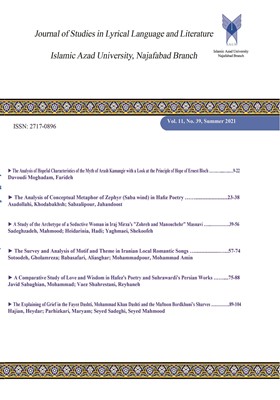The Analysis and Comparison of the Details of the Prominent Khorasani Poets with Arab Poets
Subject Areas : Persian Language & Literature
Hossein Ali Sarhadi
1
,
Masoud Akbarizadeh
2
,
Mostafa Salari
3
![]()
1 - Ph.D. Candidate, Persian Language and Literature, Zahedan Branch, Islamic Azad University, Zahedan, Iran.
2 - Assistant Professor, Persian Language and Literature, Zahedan Branch, Islamic Azad University, Zahedan, Iran.
3 - Assistant Professor, Persian Language and Literature, Zahedan Branch, Islamic Azad University, Zahedan, Iran.
Keywords: Khorasani style, Amir Moezzi, Manouchehri, Farrokhi, Nasser Khosrow, Atlal and Daman, Seven Pendants,
Abstract :
Seven Pendants (Moallaghat -e Sab’eh) is one of the great cultural treasures of mankind and one of the honors of the history of Arabic literature and literature. Iran has been influenced by Arabic language, literature and culture due to its proximity to Arab lands. Although this effect is reciprocal and profound; But undoubtedly the influence of Arabic literature on the poets of the early periods of Persian literature has been deeper and greater. One of the main objectives of this research is to analyze and compare the poems related to the description of Atlalal and Deman in Seven Pendants with the poems of four of the most prominent poets of Khorasani style; That is, Ansari is Manouchehri Damghani, Amir Moezi and Naser Khosrow. In this research, the author intends to study, analyze and describe the duration and duration in the commentaries of Mo’laghat -e Sab’eh and prominent poets of Khorasani style in a descriptive-analytical manner and as a library tool. The vast majority of scholars who have written about the influence of Persian poetry on Arabic poetry in the category of description of Atlal and Daman agree that Iranian poets have followed the poetry of Arab poets and well-known Arab poets. They have used the background as a model for their work. The results of the research indicate that Persian poets, like Arab poets, have not been able to convey the feeling of sadness and separation of the lover from seeing the audience to the audience and have failed in this way and in this type of literature, their poetry has resulted in nothing but rhetoric.
آیتی، عبدالمحمد (1345). معلقات سبع. تهران: سروش.
الندوب، محمد واضح الحسنی (2002). تاریخ الادب العربی (العصر الجاهلی و العصرالاسلامی). الطبعه الثانیه. دمشق- بیروت: دار ابن کثیر.
الفاخوری، حنا (1383). تاریخ ادبیات زبان عربی،از عصر جاهلی تا قرن معاصر. ترجمه عبدالمحمد آیتی. طهران: توس.
الذبیانی، النابغه (1986). الدیوان. مقدمه و شرح کرم البستانی. بیروت: دارالمعرفه.
بدوی (2009). قضیه البکاء علی األطلال فی مقدمه القصیده. مجله المداد، 7/ ایار(مایو)، جده: مرکز مداد المتخصص للنشر و التوزیع.
جرجی، زیدان (2009). تاریخ آداب اللغه العربیه. بیروت: دار و مکتبة الحیا.
جودی نعمتی، اکرم (1382). زن در آینۀ شعر فارسی. مجلۀ مطالعات راهبردی زنان. 6 (19)، 232- 207.
ذاکری کیش، امید (1398). مؤلفههای زبان غنایی در تغزلات فرخی سیستانی. مجله متنشناسی ادب فارسی. 11 (42)، 109- 95.
شفیعی کدکنی، محمدرضا (1371). صور خیال در شعر فارسی. تهران: نیلوفر.
شفیعی کدکنی، محمّدرضا (1372). مفلس کیمیا فروش. تهران: سخن.
شفیعی کدکنی، محمّدرضا (1375). صور خیال در شعر فارسی. تهران: آگاه.
شمیسا، سیروس (1381). شاهدبازی در ادبیات فارسی. تهران: فردوس.
شمیسا، سیروس (1386)، سبکشناسی شعر. تهران: میترا.
عنصری، ابوالقاسم حسن (1341). دیوان. تصحیح یحیی قریب. تهران: کتابخانۀ ابنسینا.
عوین، أحمد محمد (2002). قضایا الشعر الجاهلی. اسکندریة: دارالوفاء.
فروزانفر، بدیعالزمان (1350). سخن و سخنوران. تهران: خوارزمی.
مصفا، مظاهر (1335). پاسداران سخن. ج. 1. تهران: سینا.
معزی، امیر (1362) دیوان. مقدمه و تصحیح ناصر هیری. تهران: مرزبان.
ملازهی کهن ملک، شهناز (1395، اسفند ماه). جایگاه شعر و ادب نزد شاعران عرب زبان و فارسیزبان عهد عباسی دوم. دومین کنفرانس ملی چارسوی علوم انسانی. شیراز: مرکز توسعه آموزشهای نوین ایران
منوچهری دامغانی، احمد (1363). دیوان، تصحیح دکتر محمد دبیر سیاقی. تهران: زوار.
قبادیانی، ناصرخسرو (1385). دیوان اشعار. به تصحیح مجتبی مینوی و مهدی محقق. تهران: دانشگاه تهران.
یوسفی، غلامحسین(1370). فرخی سیستانی (بحثی در شرح احوال و روزگار و شعر او). تهران: علمی.
_||_Al-Fakhouri, H. (2004). History of Arabic language literature, from the pre-Islamic era to the contemporary century, translated by A. Ayati, sixth Edition, Tehran: Toos.
Al-Nabegheh, Al-D. (1986). Divan. Karam Al-Bustani (Emnd.), Beirut: Dar Al-Ma'rifah.
Al-Nadub, M. (2002). History of Arabic literature (Jahiliyyah and Al-Asr al-Islami). Damascus-Beirut: Dar Ibn Kathir.
Ansari, A. (1962), Divan. Y. Gharib (Ed.). Tehran: Ibn Sina Library.
Awin, A. M. (2002). The Cases of ignorant poetry. Alexandria: Dar al-Wafa.
Ayati, A. (1966). Seven pendants. Tehran: Soroush.
Badawi (2009). The case of weeping on disruption in the introduction of Ode. Al-Madad Magazine. 7 / Mayar. Jeddah: Specialized Pencil Center for Publishing and Distribution.
Forouzanfar, B. (1971). Sokhan va Sakhnouran. Tehran: Kharazmi.
George, Z. (2009). History of Arabic language etiquette. Beirut: Dar and Maktab al-Haya.
Ghobadiani, Naser Khosrow (2006). Poetry Divan. Mojtaba Minavi and Mehdi Mohaghegh (Ed.). Tehran: University of Tehran.
Judy Nemati, A. (2003). Women in the mirror of Persian poetry. Journal of Strategic Studies of Women. 6 (19), 232-207.
Malazahi Kohan Molk, Sh. (2016). The place of poetry and literature among Arabic and Persian poets of the second Abbasid Era. Second National Conference on Humanities, Shiraz: Center for the Development of Modern Iranian Education
Manouchehri Damghani, A. (1984). Divan. M. Dabir Siyaghi (Ed.). Tehran: Zavar.
Moezzi, A. (1983). Divan. N. Hiri (Emnd.). Tehran: Marzban.
Musafa, M. (1956). Pasdaran Sokhan, Vol. 1. Tehran: Sina.
Shafiee Kadkani, M. (1992). Images of imagination in Persian poetry. Tehran: Niloufar.
Shafiee Kadkani, M. (1993). Mofles Kimia Forosh. Tehran: Sokhan.
Shafiee Kadkani, M. (1996). Images in Persian poetry. Tehran: Agah.
Shamisa, S. (2002). Homosexuality in Persian literature. Tehran: Ferdows.
Shamisa. S. (2007). Poetry Stylistics. Tehran: Mitra.
Yousefi, Gh. (1991). Farrokhi Sistani (a discussion on his biography, times and poetry). Tehran: Scientific.
Zakeri Kish, O. (2019). Components of lyrical language in Farrokhi Sistani's lyric poems. Journal of Persian Literature. 11 (42), 109-95.


